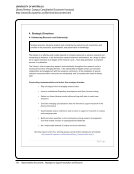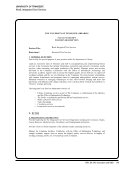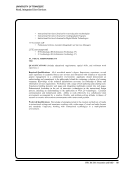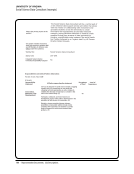24 · Survey Results: Survey Questions and Responses
these activities are coordinated and supported at the campus level by the Office of the Vice Chancellor for Research,
which coordinates grant opportunities—internal campus-wide, and external sponsored research, as well as compliance,
research integrity, conflict of interest, and technology management. Individual colleges and units may also support
research activities.
The university’s strategic plan, “Place and Promise: The UBC Plan,” references both innovation and R&D activities.
The university’s website has extensive references to both innovation and research and development and has a “culture
of innovation” as a core value. Innovation is specifically mentioned in the vision statement.
We have an office for innovation in the provost’s office, along with a vice-provost position for innovation.
LIBRARY INNOVATION: DESCRIPTION OF EXAMPLES
Please pick one example of an innovative service, product, or process in your library and answer the following questions about it.
4. Please briefly describe your library’s innovative activity and its intended outcome. N=43
A Library Resources Block (plug-in/widget) embedded in the institutional online course management system (CMS).
Embedding library resources into the CMS leads to the creation of collaborative relationships with the teaching faculty
and supports student achievement.
An intensive 3-workshop model for delivering basic instruction and orientation to at-risk students as part of a library-
campus-state collaboration was implemented in 2012 to prepare students in a two-year community college setting
to succeed at a four-year research institution. This collaboration between the university libraries, the university Bridge
Program, and the community college aims to provide students with the research skills, living skills, and acculturation
necessary to thrive in a university setting. The Bridge Program is an invitation-only living and learning community that
gives approximately 80 at-risk students who are waitlisted for admission to the university an opportunity to gradually
transition between high school to a large public research institution. Students enrolled in the program live on campus
and participate in a sequence of workshops delivering and reinforcing content most relevant to undergraduate students
in a college setting. Pre and post skills tests are delivered to assess immediate learning. Follow-up assessments are
administered to evaluate retention of skills. The project has proven successful and continues. The collaboration is a
partnership that places the library at the center of campus and state initiatives aimed at student retention and success.
Assessment was a key component of this project and has clearly demonstrated the value of library instruction and
services to student success.
Creating a User Experience (UX) Department. Within the broader context of a full reorganization of the Public Services
Division, the UX Department was established to better understand and meet the needs of users and their expectations
for a positive, worthwhile, and meaningful 21st century library experience. Going beyond the original and more
traditional interpretations of “user experience,” rooted in usability, web design, and other technologies, this department
is responsible for helping design, develop, implement, assess, and improve a broader range of services and initiatives.
Design large-scale visualization and technology spaces and associated support services into the new library. This was
done in 2008–2009 when the need was emergent.
Develop academic support and collaborative work hub within library building. Includes Writing Center, Honors Program,
Center for Teaching Excellence, Math Classrooms &Labs, Learning Support Services, Testing Lab, and Café.
Development of “Selection Manager,” a comprehensive online module that tracks collection requests evaluations,
reviews and scores trials, prices, and decisions for electronic resource selection.
these activities are coordinated and supported at the campus level by the Office of the Vice Chancellor for Research,
which coordinates grant opportunities—internal campus-wide, and external sponsored research, as well as compliance,
research integrity, conflict of interest, and technology management. Individual colleges and units may also support
research activities.
The university’s strategic plan, “Place and Promise: The UBC Plan,” references both innovation and R&D activities.
The university’s website has extensive references to both innovation and research and development and has a “culture
of innovation” as a core value. Innovation is specifically mentioned in the vision statement.
We have an office for innovation in the provost’s office, along with a vice-provost position for innovation.
LIBRARY INNOVATION: DESCRIPTION OF EXAMPLES
Please pick one example of an innovative service, product, or process in your library and answer the following questions about it.
4. Please briefly describe your library’s innovative activity and its intended outcome. N=43
A Library Resources Block (plug-in/widget) embedded in the institutional online course management system (CMS).
Embedding library resources into the CMS leads to the creation of collaborative relationships with the teaching faculty
and supports student achievement.
An intensive 3-workshop model for delivering basic instruction and orientation to at-risk students as part of a library-
campus-state collaboration was implemented in 2012 to prepare students in a two-year community college setting
to succeed at a four-year research institution. This collaboration between the university libraries, the university Bridge
Program, and the community college aims to provide students with the research skills, living skills, and acculturation
necessary to thrive in a university setting. The Bridge Program is an invitation-only living and learning community that
gives approximately 80 at-risk students who are waitlisted for admission to the university an opportunity to gradually
transition between high school to a large public research institution. Students enrolled in the program live on campus
and participate in a sequence of workshops delivering and reinforcing content most relevant to undergraduate students
in a college setting. Pre and post skills tests are delivered to assess immediate learning. Follow-up assessments are
administered to evaluate retention of skills. The project has proven successful and continues. The collaboration is a
partnership that places the library at the center of campus and state initiatives aimed at student retention and success.
Assessment was a key component of this project and has clearly demonstrated the value of library instruction and
services to student success.
Creating a User Experience (UX) Department. Within the broader context of a full reorganization of the Public Services
Division, the UX Department was established to better understand and meet the needs of users and their expectations
for a positive, worthwhile, and meaningful 21st century library experience. Going beyond the original and more
traditional interpretations of “user experience,” rooted in usability, web design, and other technologies, this department
is responsible for helping design, develop, implement, assess, and improve a broader range of services and initiatives.
Design large-scale visualization and technology spaces and associated support services into the new library. This was
done in 2008–2009 when the need was emergent.
Develop academic support and collaborative work hub within library building. Includes Writing Center, Honors Program,
Center for Teaching Excellence, Math Classrooms &Labs, Learning Support Services, Testing Lab, and Café.
Development of “Selection Manager,” a comprehensive online module that tracks collection requests evaluations,
reviews and scores trials, prices, and decisions for electronic resource selection.
































































































































































































